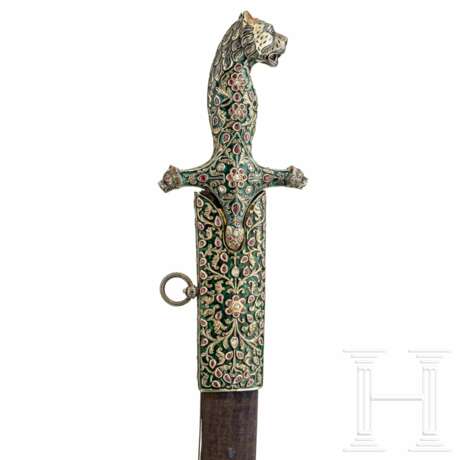Prunk-Shamshir von Asadullah Isfahani, Indien und Persien, 18./19. Jhdt., die Klinge Nadir Shah Afshar (1688 - 1747) gewidmet
23.11.2021 10:00UTC +01:00
Classic
Sold
160000EUR € 160 000
| Auctioneer | Hermann Historica |
|---|---|
| Event location | Germany, Grasbrunn / München |
| Buyer Premium | 25 % |
Archive
The auction is completed. No bids can be placed anymore.

ID 657904
Lot 1029 | Prunk-Shamshir von Asadullah Isfahani, Indien und Persien, 18./19. Jhdt., die Klinge Nadir Shah Afshar (1688 - 1747) gewidmet
Estimate value
€ 40 000
Kräftige, leicht gekrümmte Klinge aus Wootzdamast, am Ansatz beidseitig sowie auf dem Klingenrücken mit goldtauschierten Inschriften versehen, darunter u. a. die Basmala sowie die Widmung an Nadir Shah ("Nadir Tadjdar") und die Signatur "Asadullah Isfahani". Polychrom emailliertes, reich mit Diamanten und geschliffenen Rubinen verziertes Gefäß aus vergoldetem Silber mit prächtigem Blatt- und Rankendekor, die Enden der Mitteleisen und der Knauf in Tigerköpfen endend. Samtbezogene Holzscheide mit en suite zum Gefäß dekorierten, ebenfalls diamant- und rubinbesetzten Beschlägen und zwei reliefierten Trageringen. Länge 101 cm.
Nadir (oder Nader) Schah Afschar wurde am 22. Oktober 1688 in Dastgerd in Chorasan geboren und starb am 20. Juni 1747 in Quchan, indem er durch Gefolgsleute ermordet wurde.
Er stammte aus vergleichsweise einfachen Verhältnissen. Als sein Vater, ein Kleinbauer und Hirte, starb, wurden er und seine Mutter gefangen genommen und als Sklaven verkauft. Nadir konnte der Sklaverei entkommen und wurde schon in jungen Jahren der Anführer einer Söldnerschar. Er eiferte seinen Vorbildern Dschingis Khan und Tamerlan nach und verdiente sich rasch einen Ruf als genialer Feldherr. Historiker bezeichneten ihn verschiedentlich als „zweiten Alexander“ oder „Napoleon Persiens“. Er regierte später als Schah Persiens von 1736 bis 1747 und gründete die Dynastie der Afschariden. Sein Herrschaftsgebiet reichte vom Kaukasus bis zum Indus und ans Südufer des Persischen Golfs. Einer seiner Feldzüge führte ihn 1738 auch bis nach Delhi ins Reich der Mogulkaiser. Als Nadir Schah die Stadt erobert hatte und sie im Mai 1739 wieder verließ, nahm er tausende von Sklaven mit sich. Er erbeutete auch den berühmten Pfauenthron, der anschließend zum Symbol aller persischen Herrscher wurde. Zu seiner Beute gehörten angeblich 700 Elefanten, 4.000 Kamele und 12.000 Pferde. Sie zogen Wagen, die allesamt mit Gold, Silber und Edelsteinen beladen waren, zu den u. a. die berühmten Diamanten Koh-i-Noor („Berg des Lichts“) und Darya-ye Noor („Meer des Lichts“) zählten.
Zustand: II -
A marvellous Perso-Indian shamshir by Asadullah Isfahani, 18th/19th century, the blade dedicated to Nadir Shah Afshar (1688 - 1747)
The sturdy, slightly curved blade made of wootz-Damascus, the root and the back of the blade with gold-inlaid inscriptions on both sides, including the Basmala (first verse of the Koran), the dedication to Nadir Shah ("Nadir Tadjdar") and the signature "Asadullah Isfahani". The gilt silver hilt enamelled in colour, lavishly adorned with diamonds and polished rubies, fabulous foliage and decorative tendrils, the ends of the crosspiece and the pommel terminating in tiger's heads. The velvet covered wooden scabbard with fittings decorated en suite to the hilt, also set with diamonds and rubies, and two suspension rings in relief. Length 101 cm.
Nadir (or Nader) Shah Afschar was born on 22 October 1688 in Dastgerd in Khorasan and died on 20 June 1747 in Quchan, when he was assassinated by his retinue.He was of comparatively humble birth. On the death of his father, a peasant farmer and shepherd, he and his mother were taken prisoner and sold as slaves. Nadir was able to escape from his servitude and, as a young man, became the leader of a group of mercenaries. Following in the footsteps of his idols, Genghis Khan and Timur, he quickly won a reputation as a brilliant strategist. Historians have variously described him as the "Second Alexander" and the "Napoleon of Persia". He subsequently ruled as the Shah of Persia from 1736 to 1747 and founded the Afsharid Dynasty. His dominion stretched from the Caucasus to the Indus and to the south bank of the Persian Gulf.
In 1738, one of his campaigns also took him to Delhi, the kingdom of the Mughal emperors. When Nadir Shah conquered the city and left again in May 1739, he took thousands of slaves with him. Moreover, he captured the famous Peacock Throne, which subsequently became the symbol of all Persian rulers. Legend has it that his spoils included 700 elephants, 4,000 camels and 12,000 horses. They pulled wagons, all of which were loaded up with gold, silver and gemstones, among them the celebrated diamonds Koh-i-Noor ("Mountain of light") and Darya-ye Noor ("Sea of light").
Condition: II -
| Auction house category: | Weapons and Armor Persian Empire |
|---|
| Auction house category: | Weapons and Armor Persian Empire |
|---|
| Address of auction |
Hermann Historica Bretonischer Ring 3 85630 Grasbrunn / München Germany | ||||||||||||||
|---|---|---|---|---|---|---|---|---|---|---|---|---|---|---|---|
| Preview |
| ||||||||||||||
| Phone | +49 (0)89 5472 649 0 | ||||||||||||||
| Fax | +49 (0)89 5472 64999 | ||||||||||||||
| Buyer Premium | 25 % | ||||||||||||||
| Conditions of purchase | Conditions of purchase | ||||||||||||||
| Business hours | Business hours
|

















